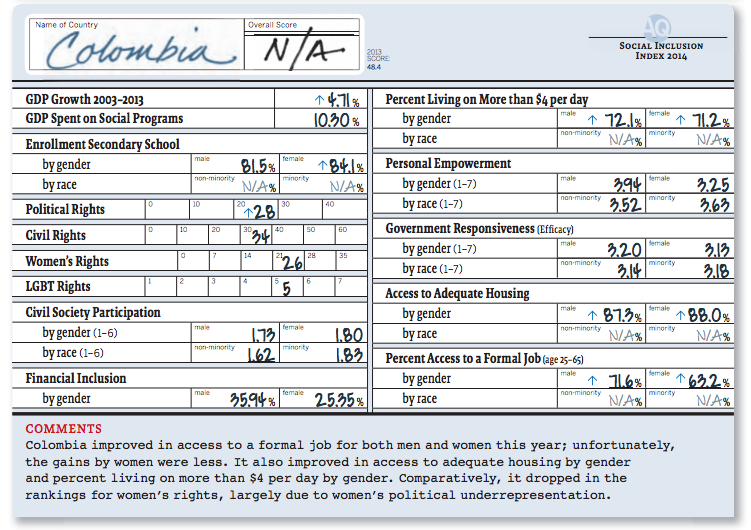Despite being in the top 5 of Latin American countries when it comes to the proportion spent on social inclusion, Colombia is still lagging behind when it comes to civil participation, government responsiveness and human rights, according to a report issued on Tuesday.
Colombia ranked 11th out of 17 Latin American countries for social inclusion, according to the report from by Americas Quarterly, a policy analysis journal covering economics, politics and social development in the Western Hemisphere. The survey was published on Tuesday by the Americas Society/Council of the Americas (AS/COA).
Colombia slipped two places this year in the annual Social Inclusion Index, compared to 2013. The index measure social inclusiveness, that is, how easy it is for all sectors of society to participate in the political and social life of the country.
The index ranks 17 countries on many factors designed to pinpoint a country’s potential to improve social mobility, such as GDP growth and poverty rates. It also focuses on the range of civil, political, and gender rights as well as the accessibility of basic living conditions such as stable housing, schooling and a formal job. Disability rights and access to justice were two new variables added this year.
The index uses data from the World Bank’s Global Financial Inclusion Index as well as survey data provided by the Latin American Public Opinion Project at Vanderbilt University and the UNDP Human Development Report to amass their annual results.
“We believe this comprehensive approach provides the best measure of a citizen’s ability to participate meaningfully in the political system and in the broader national community – and this to realize his or her potential,” the report said.
The Index
While an overall trend in economic growth and poverty reduction was noted across most countries, social issues such as women’s rights, social spending, and perceptions of personal empowerment and government responsiveness were lower on average.
Topping the index in 2014 was Uruguay, followed by Chile, Argentina, Costa Rica and the United States, who scored high in political and civil rights and displayed a strong average GDP growth, excluding the US.
The “Northern Triangle,” El Salvador, Paraguay, Honduras, and Guatemala fell at the bottom of the 2014 index, demonstrating some of the lowest scores in women’s rights, personal empowerment, and perception of government responsiveness according to the data. The latter three were also in the bottom four of the 2013 index.
Colombia improves socioeconomically, lacks women’s rights and representation
Colombia saw a greater GPD growth in 2014, and possesses one of the highest rankings in percent of GDP spent on social programs (five out of 17).
The country also saw a notable increase in female enrollment in secondary education, political rights, and the percentage of people living on more than $4 per day for both female and male citizens.
Access to adequate housing and formal jobs also increased across both genders.
Colombia still lags in rankings for women’s rights, largely due to the under-representation of women in politics. Similarly, social factors such as government responsiveness, civil society participation, and personal empowerment either did not change or went down in 2014.
Lack of information regarding race and ethnicity in Colombia’s census data resulted in unanswered questions regarding the access to education, formal jobs, and housing of the sizable Afro Colombian and Indigenous communities, which weakened Colombia’s overall social inclusion rating.
Recommendations from Americas Quarterly included increasing secondary school enrollment for Afro and indigenous Colombians as well as expanding formal employment for these groups.
Improving legal protection for women’s economic opportunities, as well as establishing women’s quota laws for government positions were also endorsed by the experts.
Sources
- Americas Quarterly Social Inclusion Index 2014 (Americas Quarterly)
- Americas Quarterly Social Inclusion Index 2013 (Americas Quarterly)
- Americas Quarterly Social Inclusion Index 2014: Amid Growth and Improvement, Patterns of Exclusion Remain (Americas Quarterly, press release)
- Interview with Christopher Sabatini (Colombia Reports)




